I haven't provided detailed commentary on the US labour market for a while now. To…
Labour market – going backwards now
Today the ABS released the Labour Force data for July 2010 which show that the unemployment rate is rising (now 5.3 per cent up from 5.1 per cent) and hours worked declining for the second consecutive month. Full-time employment is falling with net job creation being driven by part-time. Employment growth overall has been struggling to keep pace with the population growth and now it has fallen behind. The decline in full-time employment is also translating into declining aggregate hours worked which suggests that underemployment will also be rising. But a positive note is the reversal in the falling participation rate. While the bank economists have hailed today’s figures as indicative of “a healthy labour market”, the reality is that the data is consistent with a broad array of statistics showing the Australian economy is slowing as the effects of the fiscal stimulus dissipate and and private spending remains subdued. It is not a healthy labour market at all.
The summary ABS Labour Force (seasonally adjusted) estimates for July 2010 are:
- Employment increased 23,500 (+0.2 per cent) with full-time employment decreasing by 4,200 and part-time employment increasing by 27,700. The trend back to the dominance of part-time job creation is established and is also showing up in declining hours worked.
- Unemployment increased 24,600 (4.1 per cent) to 631,800.
- The official unemployment rate rose to 5.3 per cent.
- The participation rate rose by 0.2 percentage points to 65.5 per cent. Some of the hidden unemployed have clearly re-entered the labour force but not been able to find work.
- Aggregate monthly hours worked decreased 7.2 million hours (-0.5 per cent) for the second consecutive month.
- The quarterly underemployment estimates do not come out until August. But with part-time employment growth dominating and aggregate hours falling underemployment will have risen again over the last two months. This means that total labour underutilisation will have also increased in July and will be edging back towards 13 per cent.
This is how today’s data was reported on the ABC news – Unemployment rises, full-time work falls.
… the increase in the unemployment rate from 5.1 to 5.3 per cent was not predicted by any of the 20 economists surveyed by Bloomberg. The rise in unemployment was mainly caused by a 0.2 percentage point rise in the participation rate (the percentage of people looking for work) to 65.5 per cent.
While most of the commentary from the bank economists was about how strong a picture the data presented, there was some reserved commentary:
It’s the first soft jobs report after a run of very strong readings. It adds to evidence that the Australian economy is doing OK, but not great We’ve got the biggest mining boom in history but other sectors are not doing so hot. At the same time, serious doubts have arisen about the strength of recoveries in the US, UK and Europe. The next inflation report in October is likely to be benign and rates are on hold for the rest of this year. Where policy goes next year is in the lap of the gods …
I think the comment that Australia is in the midst of “the biggest mining boom in history” juxtaposed against the reality that employment growth cannot even keep pace with the growth in the labour force is a telling reminder that the mining industry is not as important as the mining lobby would have us all believe.
Indeed, the labour markets in the mining states of Western Australia and Queensland deteriorated the most in July.
The mining industry employs only a small number of workers and if we closed it down overnight the impacts on the Australian economy would be noticable but not significant. In the climate change debate that has been on-going for some years, the mining lobby has indicated that the economy would collapse if we close down the coal industry as an example.
I also think the statement that “policy goes next year is in the lap of the gods” is a telling reminder of the policy vacuum that is now in place in Australia. Both major political parties are claiming they will deliver budget surpluses the year after next without any comprehension of what the cut backs will mean for economic growth.
The Sydney Morning Herald report claimed that there are now:
… conflicting signals about the strength of the economy and as the economy shed full-time positions … the data show that the jobs picture is not as bright as had been thought, with revision to the June statistics. Originally, the ABS reported that 18,400 full-time jobs were created in June. It was actually 12,200, the most recent calculations show. On the part-time front for the same month, the original 27,500 figure was chopped back 25,200 …
Other areas of the economy are less robust. Business confidence slumped to a 14-month low in July, according to a survey out earlier this week. Retail sales remain soft, although consumer confidence picked up last month. The key housing sector, meanwhile, is cooling with auction clearance rates falling and new home loans dropping to a nine-year low in June.
Today’s data is consistent with a swathe of other indicators which tell me that the economy is not in good shape and needs further fiscal support. It was obvious that the labour market would continue to slide this month and I wonder how much the banks stake their financial outcomes on the forecasts of their economists. They are typically wrong.
The message that I take from the data is that the impacts of the declining fiscal stimulus are not being replaced by a return to strong private spending growth.
The only net jobs created in July were part-time and given that aggregate working hours also continued to fall it is clear that underemployment will have risen. The rising unemployment and underemployment will result in an increase in the total labour underutilisation rate.
Further, full-time employment growth is now negative and overall net job creation is now falling behind the growth of the labour force. While participation did increase by 0.2 per cent last month it is still down on the previous peak and so employment growth will have to quicken in the coming months just to keep pace with the labour force growth.
The economy seems incapable of maintaining the growth spurt that accompanied the peak of the fiscal stimulus.
Employment growth positive but falling of the pace
The following graph shows the month by month growth in full-time (blue columns), part-time (grey columns) and total employment (green line) over the last 12 months to July 2010 using seasonally adjusted data The overall picture is mildly positive but declining.
The sample period covers the latter parts of the downturn (July 2009 to August 2009) as full time employment growth was negative and part-time growth was mostly positive, which kept a lid on the overall employment losses although the slack showed up in lost hours of work, which was a notable feature of the downturn.
By September 2009, the effects of the fiscal stimulus package introduced in February 2009 were now evident and employment growth started to pick up quickly with growth in full-time employment signalling renewed optimism.
In the more recent period, full-time employment growth has slowed and in July was negative fro the first time in 11 months. All net employment creation is now part-time.
While employment growth remains positive it has slowed in the last month. It is clear that the impacts of the fiscal stimulus, which drove GDP growth in the March quarter (see Australia GDP growth flat-lining) are now dissipating and private spending is not yet strong enough to really push the labour market to the next level of recovery.
So the picture is not one of strength. If the full-time growth is now negative and the labour market is increasingly adding part-time jobs then we can expect any declines in official unemployment (as employment growth strengthens) to be offset to some extent by rising underemployment. As noted below, aggregate hours worked fell in July which is a sure sign that underemployment is rising.
In summary, employment growth is now not keeping pace with the labour force growth and so unemployment is once again rising. Under these conditions, long-term unemployment will steadily rise as the different cohorts move through the duration categories.
The following graph shows the movement in the labour force and total employment since the low-point unemployment rate month in the last cycle (February 2008). The two series are indexed to 100 at that month. You can see that in the last month, employment and the labour foce are running parallel (growth rates match).
So the data is telling us that there is not yet any robust labour market recovery underway. Australia just missed an official recession courtesy of the fiscal stimulus but is now exhibiting fairly sluggish but positive growth. There is definitely as a case to be made for continued fiscal support for aggregate demand.
Employment growth going backwards for teenagers
The following Table shows the distribution of net employment creation since December 2009 (to July 2010) by full-time/part-time status and age category (15-19 year olds and the rest). Despite the employment growth since the beginning of this year, teenagers overall have experienced declining employment. The jobs market has shrunk for them overall.
Morever, while male teenagers have gained zero net jobs, female teenagers have gone backwards.
It is also notable that teenagers have actually lost jobs part-time jobs. So they are not sharing at all in the only jobs growth in the economy in recent months.
The next graph shows the evolution of teenage unemployment rates (male, female, total) since the crisis began in February 2008. It is clear that teenage unemployment rates are continuing to rise even though the economy has been in mild recovery. The step-jump that occurred in November 2008, just before the first fiscal stimulus became effective, has not been reversed despite overall growth in the labour market. So while this is not a jobless recovery overall, teenagers are going backwards.
If we consider their exposure to underemployment and the fact that total labour underutilisation rates are around 26 per cent for our teenagers (sum of unemployment and underemployment) then you wonder how the bank economists can keep saying the Australian economy is close to full employment.
You also wonder why this is not one of the key issues in the current federal election campaign – more on this later.
The next graph plots the evolution of the 15-19 year old unemployment rate and the nationwide unemployment rate indexed to 100 at February 2008 – the low-point unemployment rate in the previous cycle) to July 2010.
It is clear that the modest recovery that has occurred in the Australian economy has not been beneficial to our youngest workers.
These workers are our future. We talk of the intergenerational demands on public spending and rising dependency ratios. But then we allow 26 odd percent of our future workers to remain idle and outside the skill development process. This waste ensures our future productivity growth will be lower than it otherwise could be.
Unemployment
The unemployment rate rose to 5.3 per cent in July 2010 (from 5.1 per cent in June). Employment growth has now fallen behind the growth in the labour force.
With fiscal policy tightening over the last few months as the Government (or a successful Opposition at the August 21 election) mindlessly pursues budget surpluses I expect this situation to worsen.
The following graph updates my 3-recessions graph which depicts how quickly the unemployment rose in Australia during each of the three major recessions in recent history: 1982, 1991 and now 2009 (the latter to capture the 2008-2010 episode). The unemployment rate was indexed at 100 at its lowest rate before the recession in each case (June 1981; November 1989; February 2008, respectively) and then indexed to that base for each of the months as the recession unfolded.
For 1991, the end-point shown is the peak unemployment which was achieved some 38 months after the downturn began.
For the other series, I have just charted the evolution for the 30-months in the current cycle (to July 2010 – the length of the current deterioration since February 2008). So it gives us a view of the way the 1982 recovery began too. While the 1982 recession was severe the economy and the labour market was recovering by the 26th month.
It is significant that the current situation while significantly less severe than the previous recessions is dragging on given the lack of private spending growth.
The graph provides a graphical depiction of the speed at which the recession unfolded (which tells you something about each episode) and the length of time that the labour market deteriorated (expressed in terms of the unemployment rate).
From the start of the downturn to the 30-month point (to July 2010 – the length of the current deterioration since February 2008), the official unemployment rate has risen from a base index value of 100 to a value 137.5 – peaking at 145 after 21 months. At the same stage in 1991 the rise was 85.7 per cent (and increasing) and in 1982 79.6. The 1982 recession which was fairly severe ended at the 26-month point and the economy began a painful recovery after that month.
So the current downturn has been a very different type of episode relative to our previous experiences. But the fact remains that the promising employment growth from early 2009 (see graph above) which lasted while the fiscal stimulus was impacting significantly on employment growth is not gone and the retrenchment of the unemployment rate is temporarily stalled. That is bad news.
Note that these are index numbers and only tell us about the speed of decay rather than levels of unemployment. Clearly the 5.1 per cent at this stage of the downturn is lower that the unemployment rate was in the previous recessions at a comparable point in the cycle although we have to consider the broader measures of labour underutilisation (which include underemployment) before we draw any clear conclusions.
The underemployment data is quarterly and will come out again in August. But the reality is that underemployment is a much more serious issue than it was in the 1991 and 1982 recessions and so the proportional difference between total labour underutilisation now is much less than the proportional difference between the official unemployment rates.
How much did the participation rate rise add to the labour force?
The labour force is a subset of the working-age population (those above 15 years old). The proportion of the working-age population that constitutes the labour force is called the labour force participation rate. It rose by 0.2 percentage points in July 2010.
So the labour force can increase as a result of general population growth and/or increases in the labour force participation rates. The following Table decomposes the change in the labour force between June 2010 and July 2010 into these two components: (a) change in the working age population; and (b) change in the labour force participation rate.
You can see that the rise in unemployment was essentially the result of an increasing labour force outstripping the very modest employment growth.
Hours worked – declined for second consecutive month
The rebound in aggregate monthly hours worked in May has now given way to two consecutive months of declines. In June part-time employment growth dominated and full-time employment growth continued to slow. The result was that aggregate monthly hours worked fell by 6.4 million hours (-0.4 per cent). That trend has now consolidated with full-time employment growth declining in July while part-time employment continued to expand.
The following graph is taken from the the ABS data and shows the trend and seasonally adjusted aggregate hours worked indexed to 100 at the peak in February 2008 (which was the low-point unemployment rate in the previous cycle).
You can see a very flat V-shaped recovery with a positive trend. The national economy overall is now around the previous peak of July 2008 but doesn’t appear to be able to go beyond that at the moment, with the correction in June and July 2010 being negative.
Policy proposals in current election
In July 2002, the leader of the Opposition Tony Abbott was my guest in Newcastle. At the time he was the Federal Minister for Employment and Workplace Relations in the conservative Howard Government.
He gave a Public Policy lecture and we had private meetings during the day.
During those private meetings we discussed the fact that there were not enough jobs overall and so any of the supply-side policy measures that his government was advocating were only queue shuffling exercises.
We discussed my Job Guarantee proposal and it was interesting that the Minister expressed interest in the idea. He understood that a Job Guarantee would be more effective vehicle than the Work for the Dole scheme.
We discussed at some length our plan to replace Work for the Dole with a publicly funded job guarantee in areas of community development. We understand that he instructed his Department at the time to explore this concept.
However, within weeks he was moved to the Health portfolio and his replacement Kevin Andrews proved to be totally without imagination.
In this blog – Boondoggling and leaf-raking … I describe in detail the response that the Job Guarantee proposal, which by 2003 had become official policy of the Australian Local Government Association (ALGA), received from Andrews in his role as the Minister for Employment.
His response came via a letter to ALGA on August 13, 2004. This letter outlined why the Federal Government of the day rejected the Job Guarantee. You can read this letter (and laugh a lot) HERE. The then Opposition Employment spokesperson, Jenny Macklin did not respond to ALGA which was hardly a surprise given the lack of policy development within the Labor Party in this area.
Without breaching confidentiality, at my private meetings with Mr Abbott in 2002 I explained how he could stagger the introduction of the Job Guarantee. First, he might start by offering a guaranteed public sector job to unemployed teenagers. Second, once the system had bedded down he might broaden the scheme to include all long-term unemployed. Third, the final step would be to make an unconditional job offer to all unemployed persons.
As he started to understand what the Job Guarantee was and how this staggering could make it easy to sell politicially, he turned to me and said with a grin:
That would fxxx the Labor Party wouldn’t it. That is what they should be doing …
The quote is not exact because I didn’t take notes but it is pretty much what was said.
It was clear to him that the protection of unemployed workers via a public sector job creation scheme should be a core concern for the Labor Party given that they began as the political arm of the trade union movement. At the time, they were languishing in opposition and trying to out-supply-side the conservatives. That is, they were totally imbued with policies that “blamed the victims” (training, punitive measures to deny the disadvantaged their income entitlements etc).
They were totally against public sector job creation and were actually more neo-liberal than the conservatives. Abbott understood this point and saw the introduction of a Job Guarantee as a way of stealing their natural political constituency. It was a pity that he shifted portfolios so soon after our interactions and was replaced by a total bone-head.
So I was interested to hear Tony Abbott, now as the Opposition Leader trying to win office on August 21, announce that if he won office, his government would introduce a Youth Job Guarantee.
Abbott’s specific proposal (as much as there is detail) would see “young people volunteer to give up their benefits in return for a guaranteed job” ((Source). He credits an indigenous leader for the idea.
But wherever the idea came from I consider it was the best policy announcement of the federal election campaign to date. However, without knowing the detail I remain very suspicious that the conservatives will actually introduce a decent public sector job creation program.
But at least their rhetoric is superior to that of the Government which doesn’t take much.
According to a report in the Sydney Morning Herald today (August 12, 2010) – Job seeker relocation trial to be revived – the Government’s response to the labour wastage is to introduce subsidies to assist workers to relocate and to reduce the costs of hiring.
They plan to supplement these subsidies with increasingly harsh measures which will punish workers who are reluctant to move.
Accordingly, we read that:
THE federal government has pledged to revive and expand a Howard government trial to pay job seekers to relocate for work. Under the policy, long-term unemployed who choose to move to a regional area will be paid up to $6000 in expenses, or $3000 if they move to a city … the employer will also be paid $2500 to hire the relocated worker.
A few months ago, the Government’s own Employment Department told the Senate that the trial was “not a success” and “did not result in long-term jobs”.
But since when has a neo-liberal cared about evidence that gets in the road of their ideology?
Both major parties are pursuing the relocation idea. I have done a lot of media interviews in recent days on whether this approach helps. My conclusion is always that these policies are doomed to fail.
When there is a shortage of jobs overall policies like this just shuffle the unemployment queue. They also bump less skilled workers out of jobs they might otherwise get because more skilled workers have higher mobility rates.
These policies also discriminate against families who find it harder to move given housing costs and schooling etc.
Finally, employers take advantage of the subsidies and sack the workers (if they employ them at all) when the subsidy runs out.
Please read my blog – Conservatives think I am nuts for suggesting the government might create jobs – for more discussion on this point.
The workers will also be subjected to very harsh financial penalties if they leave a subsidised job.
The Australian Council of Social Service said that “the threat of welfare being cut for three months could deter people from relocating”:
Without any income, people could be left stranded with no means to return home and no money to pay for rent or groceries …
The Prime Minister claims that the penalties were about “responsibility” but failed to note that the Government had a responsibility under all the human rights treaties that it is signatory to to ensure there are enough jobs for all those who want to work.
But in the current election campaign there is zero talk of public sector job creation from the Government.
Conclusion
While the business economists are still claiming that the labour market is close to full employment the labour market data continues to tell me that there is a lot of slack left in the labour market and the recovery is starting to falter.
Similar trends are being seen elsewhere (for example, in the US) as the positive impacts of the fiscal stimulus packages are now working their way out of the expenditure system and private spending remains flat.
July saw full-time employment growth turn negative after several months of declining growth. Part-time employment growth is reemerging and with it a decline in the aggregate hours worked. So underemployment will be rising as official unemployment is steady.
Overall, employment growth is now failing to keep pace with with population growth and so long-term unemployment is rising.
Given today’s data and related data releases over the last few weeks, I am still of the view that a further fiscal expansion is required – and should be directly targeted at public sector job creation and the provision of skills development within a paid-work context. That would be a great boost to low inflation growth.
I think the lack of focus on employment and unemployment in the current federal election campaign is symptomatic of the policy vacuum that we are now in. The major parties are tripping over each other to convince us that they will get the budget back into surplus when they have no real understanding of what that means overall (for example, it means they want the private sector indebtedness to rise).
Given that there is no greater waste than unemployment and underemployment neither party deserves office if their meagre policy plans are anything to go by. Progressives might look to The Greens but I remind you they want to balance the budget over the business cycle and don’t even know what that portends. Their macroeconomic capacity is zero and the economic stance they are publicising will undermine their other good ideas in the social and environmental policy areas.
What did the people of the World do to get the politicians we have?
That is enough for today!
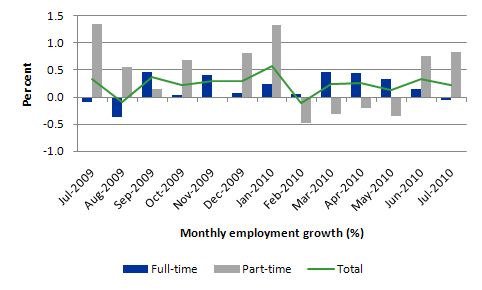
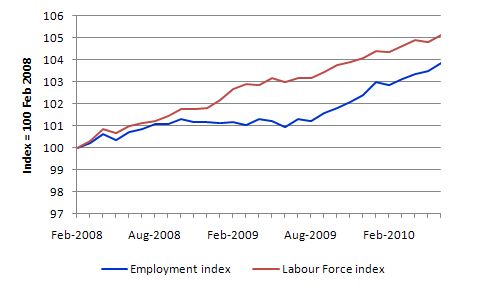

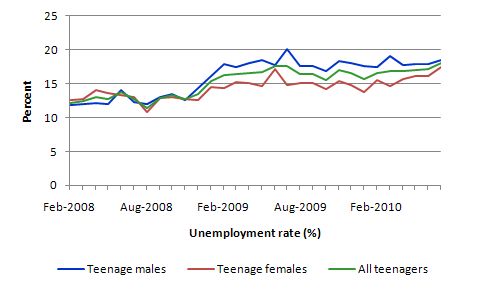
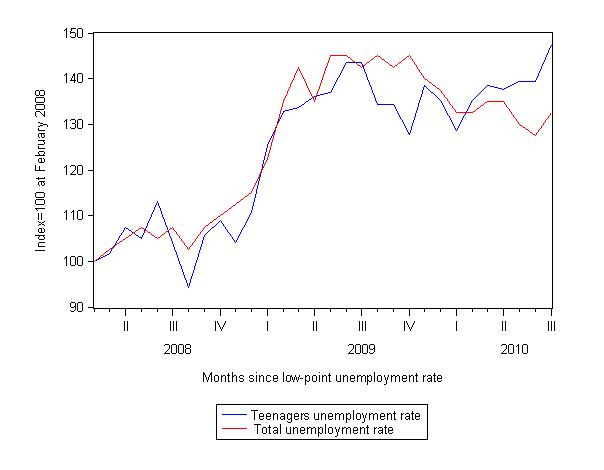
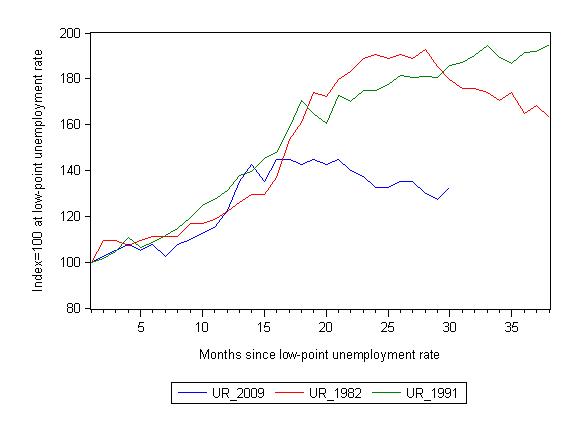

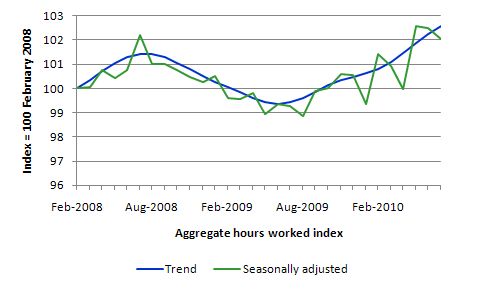
That letter is hilarious. It would have been cleared all the way through the department and illustrates how ideological constructed the public service is. I can guarantee they would have struggled with the first half, although you can see by the end they have pulled out the standard words doing the rounds at that time.
Job Network cost 1.7 billion in administered funds last year and is costed at 2 billion this year. That is equal to 40,000 50k a year jobs. That’s a lot more than actually work in the employment industry and more than they are paid.
Bill, Congratulation. You made it in the Financial Times. At least in their Alphaville Blog: “There is no money multiplier”. Now even the Federal Reserve has sincere doubts whether the money multiplier was ever alive. And Mankiw can write edition 999 of his principles.
http://ftalphaville.ft.com/blog/2010/08/12/313756/%E2%80%98there-is-no-money-multiplier/
Bill.
Another great article. Thanks. The comments re Abbott were very interesting. The changes made by the Rudd and Gillard government over this term are far worse than anything Howard did in all his years in government. This has shocked me as a former Labor voter. The compliance costs will soon be higher than the total amount spent on Newstart. Anyway, the reason for this comment is that I think the relocation proposal was cleverly disguised and spun as ‘assistance’ or ‘incentives’, but I think the real agenda is to cut people off Newstart. Following are some words from the press release:
“As part of this package, employers will receive a $2,500 financial incentive for taking on a relocated jobseeker. This subsidy will be $500 per week for the first five weeks.
If a job seeker leaves a job placement for which they received relocation assistance within 6 months without good cause, the standard non-payment penalty period for unemployment benefits will be increased by 50 per cent, from 8 weeks to 12 weeks.”
The key word is ‘placement’. It sounds like people will be forced to accept a placement that has been identified for them and if they refuse they will be cut off the dole. The press release does not say that but existing rules allow for that. I agree that the proposal is doomed to fail. The government has overlooked the difficulty of finding accommodation. In my last job, a senior manager (public service) and his wife (also public service) were transferring from Canberra to Brisbane. They both had permanent roles and very high incomes. They were shuttling back and forth between the two cities for a couple of months while they sold their Canberra house and prepared for the move. They had two teenage daughters and a dog. They wanted to rent in Brisbane for a year or so while they explored the city to decide where to buy. But they were unable to find a rental property and they believed the reason was that they owned a dog. If people like this struggle to find accommodation, unemployed people forced to relocate for these placements will have even more problems, even if they do not own pets, as landlords in a new location will not want to rent a property to a person who has been unemployed for a long time. As I said, I think the real agenda here is to cut people off the dole. And the payment of $500 to the employer over 5 weeks. What is to stop the employer taking that money and sacking the worker as you suggest and then telling the government lies that put the blame on the worker, leaving them stranded in a strange place with no money. Terrible policy.
Stephan, actually it is the 2nd time I see a link on Alphaville to Billy’s blog. Last mile so to speak 🙂
Bill ~
You perhaps are aware of this, but I happened upon “Political Aspects of Full Employment” by Michal Kalecki, an article from 1943 proposing a full employment methodolgy WITHIN capitalism, something I found curious considering Kalecki is described as a Marxist. Even if you are familiar with this, you may want to drop by and check the several comments, which provide some interesting historical background on Kalecki and his relationship to Keynes.
http://mrzine.monthlyreview.org/2010/kalecki220510.html
P.S. Congrats on the Alphaville nod. 🙂
Dear all,
Another voodoo Economics from the Guru himself
A Challenge to Extreme Keynesians
http://gregmankiw.blogspot.com/2010/08/challenge-to-extreme-keynesians.html
My brain temporarily shut down after reading Mankiw’s bloq and I need to read Bill’s article to regain sanity . . .
From the blog,
“The key insight of Keynesian economics is that the problem during recessions is inadequate aggregate demand. Taken to the extreme, which some Keynesians do, it says that aggregate demand is the only thing you need to worry about during downturns. Changes in aggregate supply (due to, say, high marginal tax rates or adverse incentives associated unemployment insurance) don’t matter, they argue, because employment is being constrained by the low level of aggregate demand.
University of Chicago economist Casey Mulligan offers a challenge to that view. Casey points out that there is a regular surge in teenage employment during the summer months because more teenagers are available to work (that is, the supply of their labor has increased). That is no surprise: It is normal supply and demand in action. But if aggregate demand were the main constraint on employment, this increase in supply should not translate into higher employment during deep recessions such as this one. But it does!”
@Anas
Read that also. I think the “communists” publishing the revolutionary socialist magazine “The Economist” debunked this nonsense with one blog entry: (http://www.econom)ist.com/blogs/freeexchange/2010/08/labour_markets_0
I maintain my argument that a revolution in the public’s understanding will likely need to occur before there is any chance of any political party offering anything other than budget surpluses.
The public is now deeply conditioned to be debt and deficit phobic. A party that goes to the polls without promising to start returning to surplus stands I believe, roughly zero percent chance of being elected. To argue that they do not deserve office may be a valid argument from an MMT perspective but it also misses the point entirely. The point is that political parties win by pandering to what the majority think they know and think they want and to directly contradict the electorates deeply and broadly held beliefs is highly likely to be akin to political suicide.
Until the public become much more accepting of the idea of government deficit, I don’t think it’s overly realistic to expect change in that department.
Dear Stephen,
Wow it came out in The Economist as well, I think by end of this week many policy maker wills read it and suffer from brain damage bacause of that, then we expect to see more stupid policy base on Voodoo Economics to emerge in the near future. . . .
Mark Thoma has refutes them; you could read it here
http://economistsview.typepad.com/economistsview/2010/08/it-such-a-silly-analysis.html
Stephen,
Sorry, I thought The Economist supports those Zombies, my mistake.